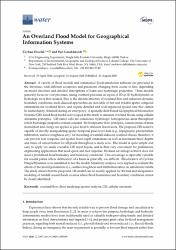| dc.contributor.author | Özçelik, Ceyhun | |
| dc.contributor.author | Gorokhovich, Yuri | |
| dc.date.accessioned | 2020-11-20T14:30:04Z | |
| dc.date.available | 2020-11-20T14:30:04Z | |
| dc.date.issued | 2020 | |
| dc.identifier.issn | 2073-4441 | |
| dc.identifier.uri | https://doi.org/10.3390/w12092397 | |
| dc.identifier.uri | https://hdl.handle.net/20.500.12809/338 | |
| dc.description | WOS: 000581411900001 | en_US |
| dc.description.abstract | A variety of flood models and commercial flood simulation software are provided in the literature, with different accuracies and precisions changing from coarse to fine, depending on model structure and detailed descriptions of basin and hydrologic properties. These models generally focus on river processes, taking overland processes as inputs of 1D or 2D hydrodynamic or hydrologic river flow models. Due to the discrete structure of overland flow and unknown-dynamic boundary conditions, such classical approaches are not cable of fast and reliable spatio-temporal estimations for overland flows, and require detailed and well-organized spatial data that cannot be immediately obtained during an emergency. A spatially-distributed Geographical Information Systems (GIS) based flood model is developed in this study to simulate overland floods, using cellular automata principles. GIS raster cells are considered hydrologic homogeneous areas throughout which hydrologic properties remain constant. Hydrodynamic flow principles, conservations of mass, momentum and energy are applied at pixel level to simulate floodwaters. The proposed GIS model is capable of directly manipulating spatio-temporal pixel level data (e.g., topography, precipitation, infiltration, surface roughness etc.) for modeling of rainfall-induced overland floods; therefore, it can provide fast, temporal and spatial flood depth estimations as well as maximum flood depths and times of concentration for all pixels throughout a study area. The model is quite simple and easy to apply via easily creatable GIS input layers, and is thus very convenient for preliminary engineering applications that need quick and fast response. Its main advantage is that it does not need a predefined flood boundary and boundary conditions. This advantage is especially valuable for coastal plains where delineation of a basin is generally too difficult. Floodwaters of Cyclone Nargis/Myanmar were simulated to test the model. Sensitivity analyses were applied to evaluate the effects of the model parameters (i.e., surface roughness and infiltration rates) on simulation results. The study shows that the proposed GIS model can be readily applied for the fast and inexpensive modeling of rainfall caused floods in areas where flood boundaries and boundary conditions cannot be clearly identified. | en_US |
| dc.description.sponsorship | Columbia University in New York City; University of Tokyo; Japan Society for Promotion of Science (JSPS)Ministry of Education, Culture, Sports, Science and Technology, Japan (MEXT)Japan Society for the Promotion of Science; Pamukkale UniversityPamukkale University | en_US |
| dc.description.sponsorship | We would like to acknowledge supports of Columbia University in New York City, The University of Tokyo, Japan Society for Promotion of Science (JSPS) and Pamukkale University. | en_US |
| dc.item-language.iso | eng | en_US |
| dc.publisher | Mdpi | en_US |
| dc.item-rights | info:eu-repo/semantics/openAccess | en_US |
| dc.subject | Overland Flow | en_US |
| dc.subject | Flood Modeling | en_US |
| dc.subject | Spatial Analysis | en_US |
| dc.subject | GIS | en_US |
| dc.subject | Cellular Automata | en_US |
| dc.title | An Overland Flood Model for Geographical Information Systems | en_US |
| dc.item-type | article | en_US |
| dc.contributor.department | MÜ, Mühendislik Fakültesi, İnşaat Mühendisliği Bölümü | en_US |
| dc.contributor.institutionauthor | Özçelik, Ceyhun | |
| dc.identifier.doi | 10.3390/w12092397 | |
| dc.identifier.volume | 12 | en_US |
| dc.identifier.issue | 9 | en_US |
| dc.relation.journal | Water | en_US |
| dc.relation.publicationcategory | Makale - Uluslararası Hakemli Dergi - Kurum Öğretim Elemanı | en_US |


















